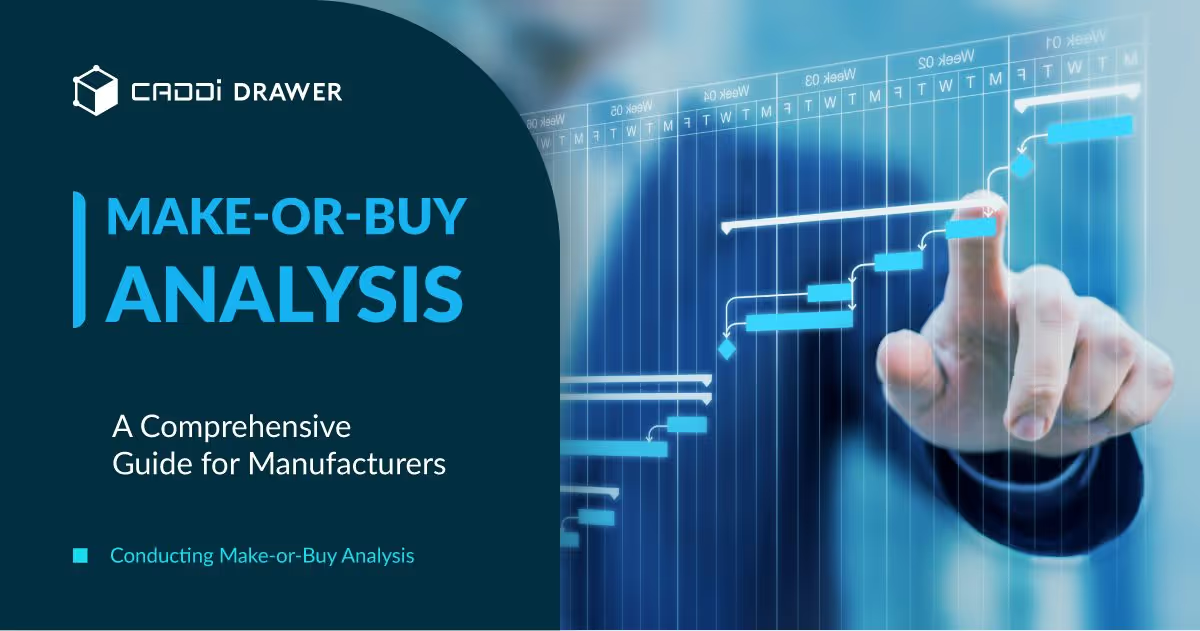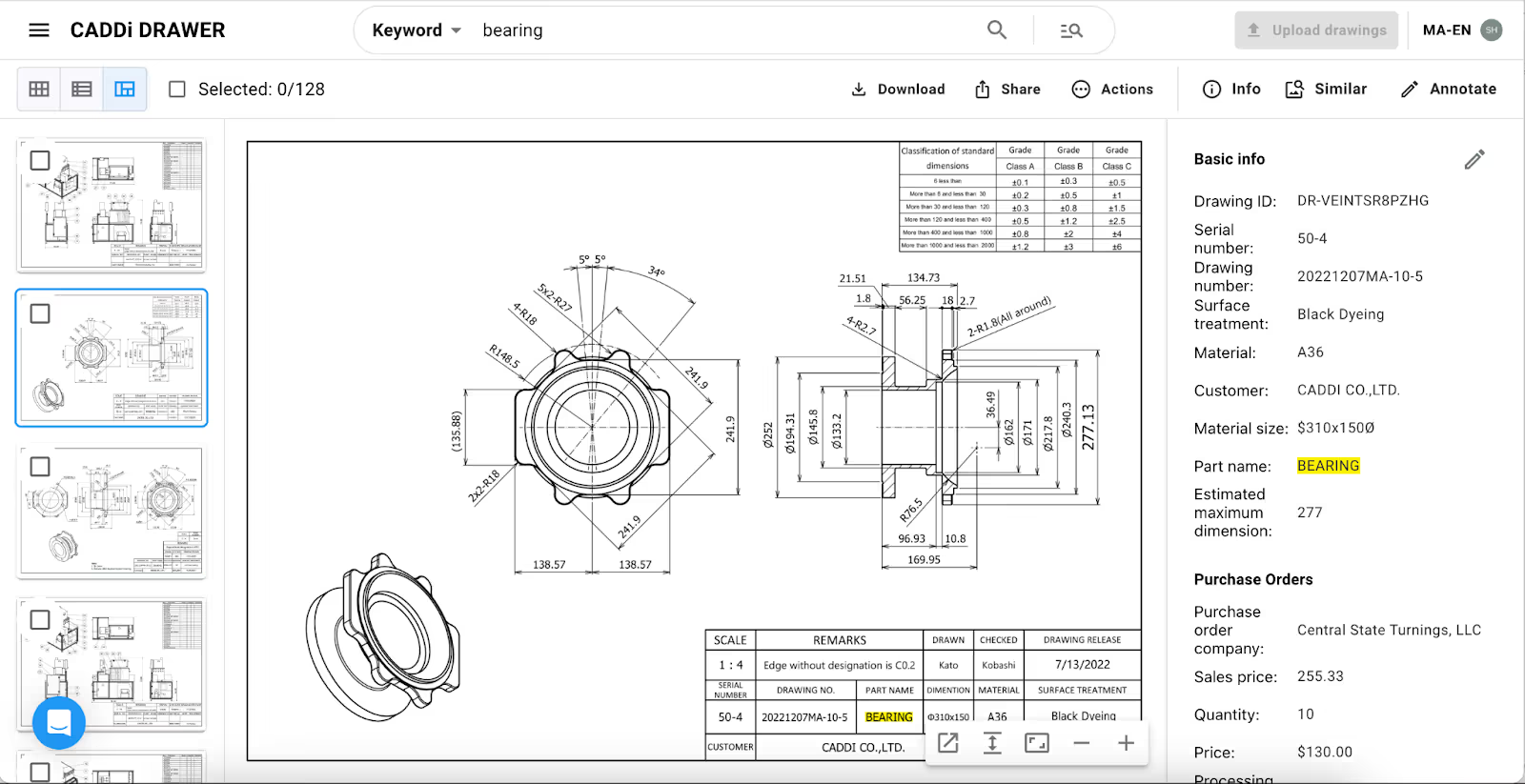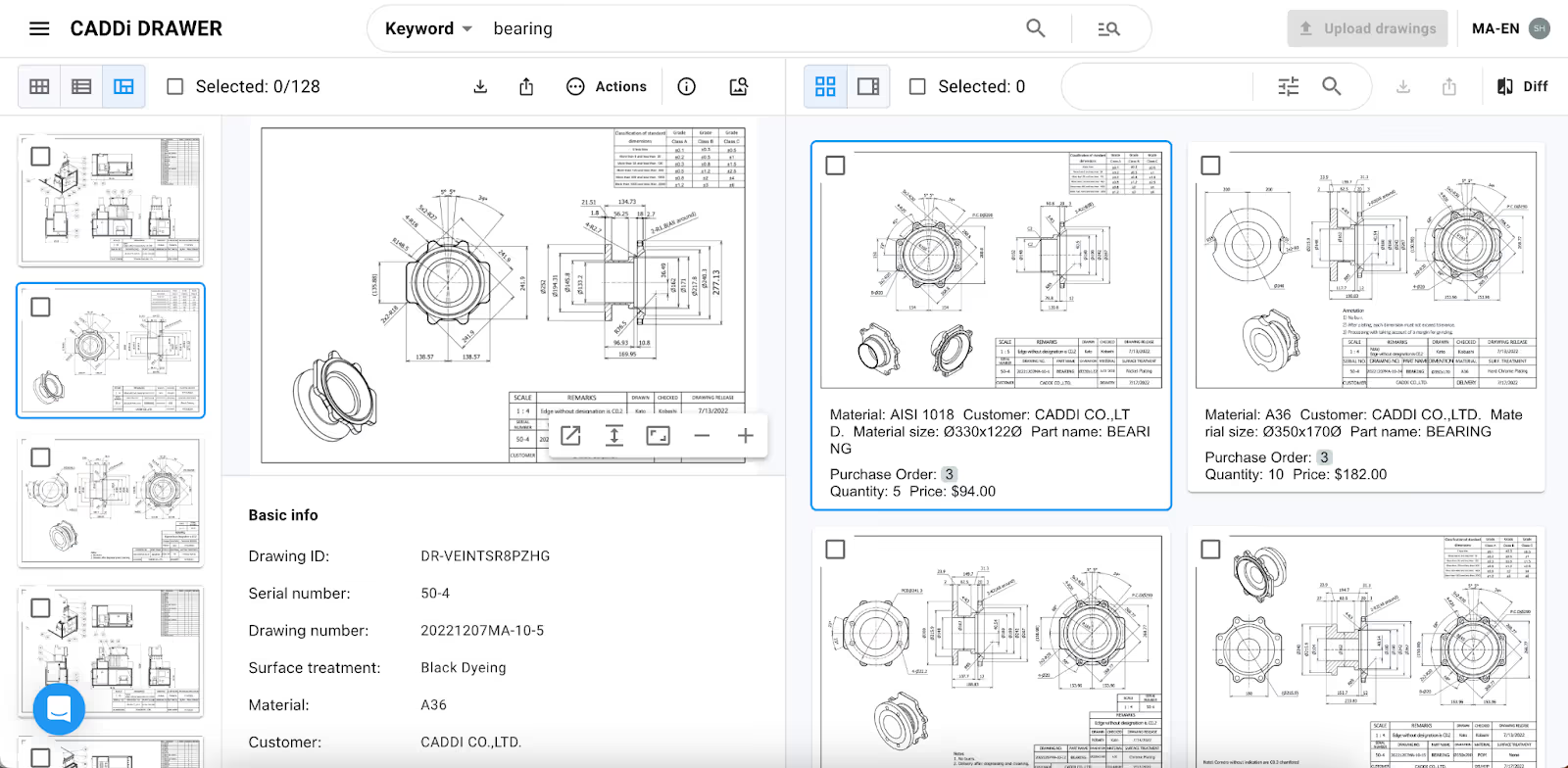Make or Buy Analysis: A Comprehensive Guide for Manufacturers

Table of Contents

Manufacturing companies are constantly faced with decisions that can significantly impact their operations, financial health, and competitive edge. One such critical decision is the make or buy analysis. This determines whether to make a component in-house or buy it from an external supplier.
This decision-making process, is crucial for manufacturers aiming to optimize their resources, minimize costs, and maintain or enhance product quality. This blog guides manufacturers through the steps of conducting an analysis and highlight the factors to consider.
Understanding Make or Buy Analysis
Make-or-buy analysis is a strategic decision-making tool used by manufacturers to assess the costs and benefits of producing a component or product internally versus purchasing it from an external supplier. This analysis takes into account various quantitative and qualitative factors, including cost, capacity, quality, and control, to determine the most cost-effective and efficient method of sourcing.
Steps for Conducting Make or Buy Analysis
The make-or-buy decision process involves several critical steps, each requiring careful consideration and analysis:
1. Identify the Components or Products for Analysis
- Start by listing all components or products currently produced in-house and those sourced from external suppliers.
- Highlight items with significant cost implications or strategic importance for further analysis.
2. Analyze In-House Production Costs
- Calculate the total cost of in-house production, including direct materials, labor, overhead, R&D, equipment, and facility expenses.
- Consider the economies of scale and the possibility of reducing costs through improved processes or technology.
3. Evaluate External Market Options
- Research potential suppliers, considering their pricing, quality, reliability, and terms.
- Request quotes and negotiate with suppliers to get the best possible terms.
4. Compare Costs and Factors
- Use a comparative cost analysis to weigh the in-house production costs against the costs of purchasing from external suppliers.
- Incorporate a break-even analysis to determine at what point the cost of making equals the cost of buying.
5. Consider Qualitative Factors
- Beyond costs, consider factors such as quality control, intellectual property concerns, supply chain reliability, and strategic partnerships.
- Assess the impact on your company’s flexibility, workload, manpower, innovation capabilities, and long-term strategic goals.
6. Make the Decision
- Based on the comprehensive analysis, decide whether to make or buy.
- Ensure the decision aligns with the company’s overall strategic objectives and financial goals.
7. Implement and Monitor
- Implement the decision, taking necessary actions to either establish in-house production or establish relationships with suppliers.
- Continuously monitor the decision’s impact on costs, quality, and supply chain efficiency, ready to reassess as market conditions change.
Factors to Consider in Make or Buy Analysis
When conducting a make-or-buy analysis, manufacturers should consider several key factors to ensure a well-rounded decision-making process:
- Cost Analysis: This includes all relevant costs associated with making or buying, such as production costs, purchasing costs, holding costs, and transaction costs.
- Capacity and Flexibility: Assess whether your current facilities have the capacity to produce the required components or products without sacrificing quality or lead times. Consider the flexibility of your operations to adapt to demand fluctuations.
- Quality Control: In-house production may offer better control over quality standards. Evaluate if external suppliers can meet your quality requirements.
- Strategic Focus: Consider how the make-or-buy decision aligns with your company’s strategic objectives. Making critical components in-house might protect proprietary technology or processes, while buying could free up resources for core activities.
- Risk Management: Evaluate risks such as supplier reliability, geopolitical factors, and market volatility. Consider how these risks could impact your supply chain and overall business operations.
- Innovation and Technological Capabilities: Consider whether in-house production allows for greater innovation and technological advancement compared to sourcing from suppliers.
- Environmental and Ethical Considerations: Assess the environmental impact and ethical implications of making versus buying, considering sustainability practices of potential suppliers.
Conducting a make-or-buy analysis is a complex but essential process for manufacturers seeking to optimize their operations and maintain a competitive advantage. By following the steps outlined above and considering the key factors involved, manufacturers can make informed decisions that align with their strategic goals, financial objectives, and operational requirements. Remember, the make-or-buy decision is not a one-time analysis but a continuous process that should be revisited regularly as market conditions, technology, and company priorities evolve.
Leveraging CADDi Drawer for Make or Buy Analysis
CADDi Drawer offers a great opportunity to manufacturers looking to conduct make-or-buy analysis and decisions. By linking all necessary data – including procurement costs, production information, and quality data – to a manufacturer’s drawings, information is available for review all in one place. This can help streamline the make-or-buy decision making process, as reviewing current procurement costs is a simple and visual process.

Reviewing similar parts is streamlined through Drawer’s patented similarity search function, which analyzes shape data within drawings to locate those most similar in the database. This allows manufacturers to gain a stronger understanding of the parts they produce most efficiently, and which they should consider outsourcing instead. In this way, CADDi Drawer empowers manufacturers to take control of their data, using it for actionable insights.

By improving the visibility of data within an organization, Drawer helps to break down departmental silos in order to improve communication and information sharing. This assists in the make-or-buy analysis, as understanding the up-to-date and relevant production data generated by manufacturers better provides context on the organization’s current capacity for production, a key point in making a make-or-buy decision. Additionally functions such as the tagging feature allow users to sort, note, and share information from the production process, and the linking of quality data from both internal and external production can improve supplier audits.
In these ways, CADDi Drawer provides additional context within the manufacturing environment, empowering users to make both short and long term decisions within the production and procurement processes. See it in action by signing up for a demo.
Manufacturing companies are constantly faced with decisions that can significantly impact their operations, financial health, and competitive edge. One such critical decision is the make or buy analysis. This determines whether to make a component in-house or buy it from an external supplier.
This decision-making process, is crucial for manufacturers aiming to optimize their resources, minimize costs, and maintain or enhance product quality. This blog guides manufacturers through the steps of conducting an analysis and highlight the factors to consider.
Understanding Make or Buy Analysis
Make-or-buy analysis is a strategic decision-making tool used by manufacturers to assess the costs and benefits of producing a component or product internally versus purchasing it from an external supplier. This analysis takes into account various quantitative and qualitative factors, including cost, capacity, quality, and control, to determine the most cost-effective and efficient method of sourcing.
Steps for Conducting Make or Buy Analysis
The make-or-buy decision process involves several critical steps, each requiring careful consideration and analysis:
1. Identify the Components or Products for Analysis
- Start by listing all components or products currently produced in-house and those sourced from external suppliers.
- Highlight items with significant cost implications or strategic importance for further analysis.
2. Analyze In-House Production Costs
- Calculate the total cost of in-house production, including direct materials, labor, overhead, R&D, equipment, and facility expenses.
- Consider the economies of scale and the possibility of reducing costs through improved processes or technology.
3. Evaluate External Market Options
- Research potential suppliers, considering their pricing, quality, reliability, and terms.
- Request quotes and negotiate with suppliers to get the best possible terms.
4. Compare Costs and Factors
- Use a comparative cost analysis to weigh the in-house production costs against the costs of purchasing from external suppliers.
- Incorporate a break-even analysis to determine at what point the cost of making equals the cost of buying.
5. Consider Qualitative Factors
- Beyond costs, consider factors such as quality control, intellectual property concerns, supply chain reliability, and strategic partnerships.
- Assess the impact on your company’s flexibility, workload, manpower, innovation capabilities, and long-term strategic goals.
6. Make the Decision
- Based on the comprehensive analysis, decide whether to make or buy.
- Ensure the decision aligns with the company’s overall strategic objectives and financial goals.
7. Implement and Monitor
- Implement the decision, taking necessary actions to either establish in-house production or establish relationships with suppliers.
- Continuously monitor the decision’s impact on costs, quality, and supply chain efficiency, ready to reassess as market conditions change.
Factors to Consider in Make or Buy Analysis
When conducting a make-or-buy analysis, manufacturers should consider several key factors to ensure a well-rounded decision-making process:
- Cost Analysis: This includes all relevant costs associated with making or buying, such as production costs, purchasing costs, holding costs, and transaction costs.
- Capacity and Flexibility: Assess whether your current facilities have the capacity to produce the required components or products without sacrificing quality or lead times. Consider the flexibility of your operations to adapt to demand fluctuations.
- Quality Control: In-house production may offer better control over quality standards. Evaluate if external suppliers can meet your quality requirements.
- Strategic Focus: Consider how the make-or-buy decision aligns with your company’s strategic objectives. Making critical components in-house might protect proprietary technology or processes, while buying could free up resources for core activities.
- Risk Management: Evaluate risks such as supplier reliability, geopolitical factors, and market volatility. Consider how these risks could impact your supply chain and overall business operations.
- Innovation and Technological Capabilities: Consider whether in-house production allows for greater innovation and technological advancement compared to sourcing from suppliers.
- Environmental and Ethical Considerations: Assess the environmental impact and ethical implications of making versus buying, considering sustainability practices of potential suppliers.
Conducting a make-or-buy analysis is a complex but essential process for manufacturers seeking to optimize their operations and maintain a competitive advantage. By following the steps outlined above and considering the key factors involved, manufacturers can make informed decisions that align with their strategic goals, financial objectives, and operational requirements. Remember, the make-or-buy decision is not a one-time analysis but a continuous process that should be revisited regularly as market conditions, technology, and company priorities evolve.
Leveraging CADDi Drawer for Make or Buy Analysis
CADDi Drawer offers a great opportunity to manufacturers looking to conduct make-or-buy analysis and decisions. By linking all necessary data – including procurement costs, production information, and quality data – to a manufacturer’s drawings, information is available for review all in one place. This can help streamline the make-or-buy decision making process, as reviewing current procurement costs is a simple and visual process.

Reviewing similar parts is streamlined through Drawer’s patented similarity search function, which analyzes shape data within drawings to locate those most similar in the database. This allows manufacturers to gain a stronger understanding of the parts they produce most efficiently, and which they should consider outsourcing instead. In this way, CADDi Drawer empowers manufacturers to take control of their data, using it for actionable insights.

By improving the visibility of data within an organization, Drawer helps to break down departmental silos in order to improve communication and information sharing. This assists in the make-or-buy analysis, as understanding the up-to-date and relevant production data generated by manufacturers better provides context on the organization’s current capacity for production, a key point in making a make-or-buy decision. Additionally functions such as the tagging feature allow users to sort, note, and share information from the production process, and the linking of quality data from both internal and external production can improve supplier audits.
In these ways, CADDi Drawer provides additional context within the manufacturing environment, empowering users to make both short and long term decisions within the production and procurement processes. See it in action by signing up for a demo.
Ready to see CADDi Drawer in action? Get a personalized demo.
Subscribe to our Blog!
Related Resources












.svg)



.svg)
.svg)
.svg)


